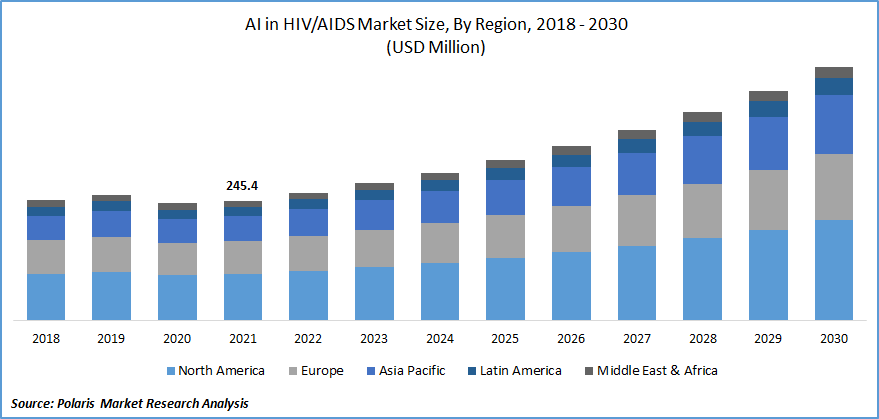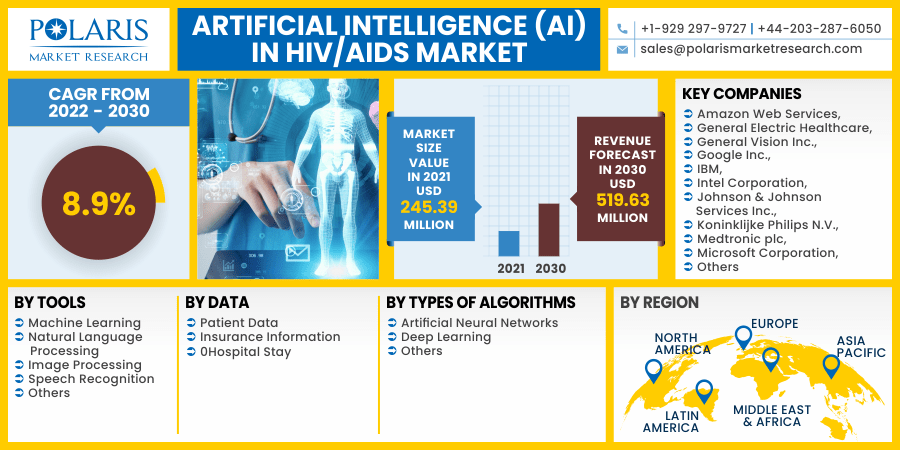
Artificial Intelligence (AI) in HIV/AIDS Market Share, Size, Trends, Industry Analysis Report
By Tools (Machine Learning, Natural Language Processing, Image Processing, Speech Recognition, Others), By Data; By Types of Algorithms; By Region; Segment Forecast, 2022 - 2030
- Published Date:Feb-2022
- Pages: 118
- Format: PDF
- Report ID: PM2288
- Base Year: 2021
- Historical Data: 2018 - 2020
Report Outlook
The global artificial intelligence (AI) in HIV/AIDS market was valued at USD 245.39 million in 2021 and is expected to grow at a CAGR of 8.9% during the forecast period. artificial intelligence (AI) in HIV/AIDS is a term used to describe the use of ML (Machine Learning), NLP (Natural Language Processing), and other algorithms in order to comprehend the complex health care data and to mimic human cognition in the analysis. The rising potential of AI-based tools for HIV/AIDs patients is anticipated to drive the AI in HIV/AIDS market growth.
 Know more about this report: request for sample pages
Know more about this report: request for sample pages
AIDs is one of the most chronic diseases caused by exposure to HIV. According to WHO (World Health Organization), over 33 million individuals have HIV infection globally. The use of artificial intelligence to determine the accurate dosage for the patient's treatment is anticipated to drive artificial intelligence (AI) in HIV/AIDS market growth.
The impact of the COVID-19 outbreak is exhibiting negative effects on communities, individuals, and societies globally. People suffering from chronic health conditions are at a greater risk of contracting and experiencing complications from COVID-19. The growing investments towards developing a vaccine for COVID-19 and the rising spending towards patient treatment are anticipated to hinder the investments towards the application of advanced intelligence in the market. Due to the outbreak, research and academic institutions have delayed or halted their research activities in this field. Further, the decline in corporate spending and government support is anticipated to hinder industry growth over the coming years.

Know more about this report: request for sample pages
Industry Dynamics
Growth Drivers
The rising use of this innovative technology by researchers globally determines the optimal sequence of medical cocktails, i.e., a combination of medications for the patients. For instance, IBM researchers in Israel utilize machine learning to make a significant breakthrough in HIV and AIDs treatment by predicting how long it takes the virus to develop immunity to that specific medical cocktail. At present, medical cocktails are used for the treatment of HIV/AIDS, and this cocktail needs to be updated as the virus changes with time.
Thus, the use of AI enables the doctor to offer HIV/AIDs patients the optimal sequence of medical cocktails at every single stage of the disease. This research by IBM researchers is being done within the framework of a European Union (EU) project, in which they collaborated with scientists from five EU countries. This helps in managing and planning the patient's treatments & care. Furthermore, the use of virtual reality tools to facilitate HIV zero disclosure and the use of advanced intelligence-powered chatbots for HIV/AIDs education is anticipated to drive the AI in HIV/AIDS industry's growth.
Report Segmentation
The market is primarily segmented on the basis of tools, data, types of algorithms, and region.
|
By Tools |
By Data |
By Types of Algorithms |
By Region |
|
|
|
|
Know more about this report: request for sample pages
Insight by Tools
The machine learning segment holds the larger shares in 2021 and is expected to lead the industry in the forecasting years. The considerable share of the segment can be attributed to the use of this technology to identify potential candidates for PrEP (pre-exposure prophylaxis) in healthcare settings across the US, Denmark, and Eastern Africa. Machine learning has huge potential in improving the delivery of PrEP. Further, the use of machine learning for causal inference in HIV prevention studies is anticipated to drive artificial intelligence (AI) in HIV/AIDS market growth.
The Natural language processing (NLP) segment is projected to show a progressive growth rate in the forecasting years. The development of a predictive model for retention in HIV/AIDs care utilizing NLP of clinical notes is anticipated to drive the segment's growth. The application of NLP to analyze clinical notes regarding HIV-positive patients is expected to offer substantial growth opportunities to the segment. Further, the application of NLP by researchers to EHR (Electronic Health Records) & insurance claims data to accurately predict HIV outcomes is estimated to drive the segment's growth.
Geographic Overview
Geographically, North America held the highest industry shares in the global AI in HIV/AIDS industry in 2021. This huge market share can be attributed to the presence of key industry players in the US, along with the rising focus toward the application of artificial intelligence solutions is anticipated to boost the growth of the industry. The increasing adoption of artificial intelligence coupled with the high healthcare spending is expected to drive industry growth in North America.
The growing investments by companies such as IBM and others towards research & development of artificial intelligence-based solutions for the treatment, cure, and diagnosis of HIV/AIDs is anticipated to offer huge industry growth opportunities. For instance, IBM researchers are using artificial intelligence solutions to predict the required combination of medicines for the treatment. Further, in May 2021, IBM launched 2nm chip technology that helps in artificial intelligence applications.
Moreover, the Asia Pacific artificial intelligence (AI) in HIV/AIDS market is anticipated to exhibit the highest CAGR over the forecasting years. The fast growth of the market in the Asia Pacific can be attributed to the increasing patient population. The growing investment by the government of the emerging nations towards research & development is anticipated to present huge market growth opportunities. The emerging countries such as South Korea, India, Japan, and China primarily attribute to market growth. Further, the surge in funding from the private sector and healthcare companies towards applying artificial intelligence in the market is anticipated to drive market growth.
Competitive Insight
Some of the major players operating in the global artificial intelligence (AI) in HIV/AIDS market include Amazon Web Services, General Electric Healthcare, General Vision Inc., Google Inc., IBM, Intel Corporation, Johnson & Johnson Services Inc., Koninklijke Philips N.V., Medtronic plc, Microsoft Corporation, NVIDIA Corporation, and Siemens Healthineers AG.
Artificial Intelligence (AI) in HIV/AIDS Market Report Scope
|
Report Attributes |
Details |
|
Market size value in 2021 |
USD 245.39 million |
|
Revenue forecast in 2030 |
USD 519.63 million |
|
CAGR |
8.9% from 2022 - 2030 |
|
Base year |
2021 |
|
Historical data |
2018 - 2020 |
|
Forecast period |
2022 - 2030 |
|
Quantitative units |
Revenue in USD million and CAGR from 2022 to 2030 |
|
Segments covered |
By Tools, By Data, By Types of Algorithms, By Region |
|
Regional scope |
North America, Europe, Asia Pacific, Latin America, Middle East & Africa |
|
Key Companies |
Amazon Web Services, General Electric Healthcare, General Vision Inc., Google Inc., IBM, Intel Corporation, Johnson & Johnson Services Inc., Koninklijke Philips N.V., Medtronic plc, Microsoft Corporation, NVIDIA Corporation, and Siemens Healthineers AG. |
